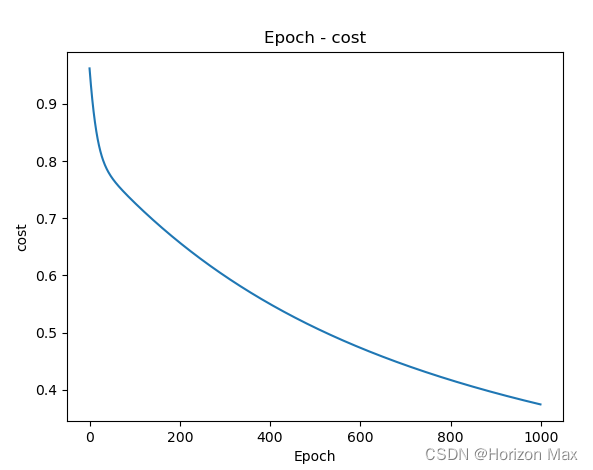🤵 Author :Horizon John
✨ 编程技巧篇:各种操作小结
🎇 机器视觉篇:会变魔术 OpenCV
💥 深度学习篇:简单入门 PyTorch
🏆 神经网络篇:经典网络模型
💻 算法篇:再忙也别忘了 LeetCode
视频链接:Lecture 06 Logistic_Regression
文档资料:
//Here is the link:
课件链接:https://pan.baidu.com/s/1vZ27gKp8Pl-qICn_p2PaSw
提取码:cxe4
Logistic_Regression(逻辑斯蒂回归)
概述
逻辑斯蒂回归 和 线性回归 之间的区别在于 激活函数 σ()
作用:
我们所使用的数据绝大多数是 非线性 的,而我们之前构造的神经网络都是 线性模型,
这样会使得我们无论怎么增加网络深度,它最终得到的模型仍是一个线性模型,
引入激活函数就能在 神经网络中引入非线性,从而构造出 非线性模型,强化网络的学习能力,
所以激活函数的最大特点就是非线性。

注:
Logistic Regression: 可以将之前的线性模型 " Linear_Model :y = wx+b " 通过 Sigmoid函数 映射到(0,1)区间内,
并通过划定的一个 阈值 ,实现大于阈值的分为一类,小于阈值的分为另一类,可以用来处理二分类问题。
常见激活函数

Code
# Here is the code :
import torch
import matplotlib.pyplot as plt
# 1 prepare dataset
x_data = torch.Tensor([[1.0], [2.0], [3.0]])
y_data = torch.Tensor([[0], [0], [1]])
# 2 design model using class
class LogisticRegressionModel(torch.nn.Module):
def __init__(self):
super(LogisticRegressionModel, self).__init__()
self.linear = torch.nn.Linear(1, 1)
def forward(self, x):
y_pred = torch.sigmoid(self.linear(x)) # 使用激活函数F.sigmoid()
return y_pred
model = LogisticRegressionModel()
# 3 construct loss and optimizer
criterion = torch.nn.BCELoss(size_average=False)
optimizer = torch.optim.SGD(model.parameters(), lr=0.01)
# 4 training cycle (forward, backward, update)
epoch_list = [] # 构建数组存放迭代过程中的 epoch 和 cost 值
cost_list = []
for epoch in range(1000):
y_pred = model(x_data)
loss = criterion(y_pred, y_data)
epoch_list.append(epoch)
cost_list.append(loss.item()/len(x_data))
optimizer.zero_grad()
loss.backward()
optimizer.step()
print('w = ', model.linear.weight.item())
print('b = ', model.linear.bias.item())
x_test = torch.Tensor([[4.0]])
y_test = model(x_test)
print('y_pred = ', y_test.data)
plt.plot(epoch_list, cost_list) # 绘图
plt.title('Epoch - cost')
plt.xlabel('Epoch')
plt.ylabel('cost')
plt.show()
运行结果

w = 1.111702561378479
b = -2.6895899772644043
y_pred = tensor([[0.8529]])
附录:相关文档资料
PyTorch 官方文档: PyTorch Documentation
PyTorch 中文手册: PyTorch Handbook
《PyTorch深度学习实践》系列链接:
Lecture01 Overview
Lecture02 Linear_Model
Lecture03 Gradient_Descent
Lecture04 Back_Propagation
Lecture05 Linear_Regression_with_PyTorch
Lecture06 Logistic_Regression
Lecture07 Multiple_Dimension_Input
Lecture08 Dataset_and_Dataloader
Lecture09 Softmax_Classifier
Lecture10 Basic_CNN
Lecture11 Advanced_CNN
Lecture12 Basic_RNN
Lecture13 RNN_Classifier






















 5万+
5万+











 被折叠的 条评论
为什么被折叠?
被折叠的 条评论
为什么被折叠?










